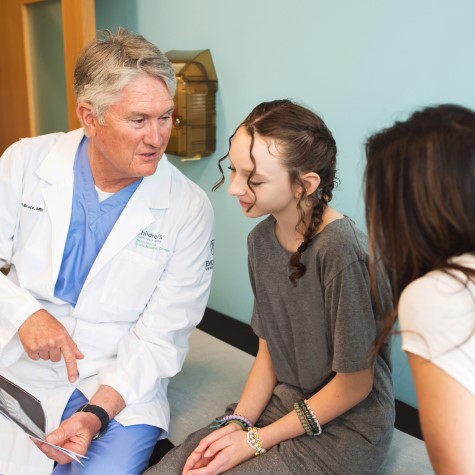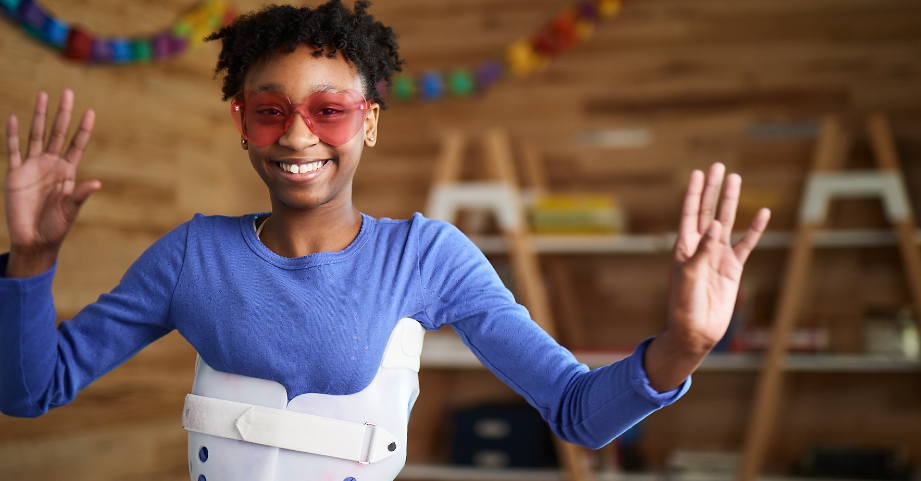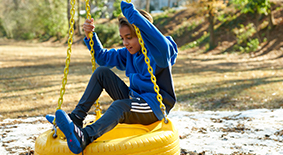Scoliosis: 4 Tips for Better Bracing
Updated 10/19/22
Wearing a back brace for scoliosis can be challenging for many kids. Often, bracing is necessary for up to 16 to 20 hour per day. Our spine specialists understand that this isn’t always easy. But with a little planning and a few precautions, you can help make the back brace more comfortable and make the most of your child’s treatment.
Depending on the curvature of the spine, doctors may prescribe a back brace for your child until she’s done growing. “Typically, we recommend the use of a brace if the child or teen’s spinal curve is more than 20 to 25 degrees and they have not finished growing,” says Joshua S. Murphy, MD, a Pediatric Orthopedic and Spine Surgeon at Children’s.
While there are different types of braces to treat scoliosis, they all are designed to stop or slow the spine’s curve from getting any worse. A lot of the time, bracing is necessary for up to 16 to 20 hour per day, so it's important to make sure it's comfortable for your child to wear their brace during that time.
“The brace is a plastic and foam device that presses on the spine to try and keep the curve from progressing,” adds C. Leigh Davis, MSPO, CPO, FAAOP, Orthotist and Prosthetist at Children’s Healthcare of Atlanta. “Our goal with the brace is to keep the curve from getting worse as the patient grows, so it's important that the patient can tolerate wearing the brace consistently."
Wearing a brace can help some kids and teens avoid surgery. "Wearing a back brace can be as important as taking medicine that is prescribed to you by your doctor,” says Dr. Murphy. “It’s crucial to stick with it, knowing consistent use can make a difference long-term.”
The key to getting your child to wear a back brace consistently is choosing “off hours” wisely and ensuring that the brace is as comfortable as possible when it’s being worn. Here are some tips from our spine specialists to help you and your child overcome some of the day-to-day challenges of bracing for scoliosis.
- Plan Bracing Breaks in Advance
Depending on your doctor’s recommendations, your child will have periods of time when she can be brace-free. This may be a couple of hours or several—use this time wisely. Save her “off hours” for going outside, playing sports or taking a dip in the pool. When she’s inside playing video games or sleeping, the brace should be on. “Wear strategies can change,” says Leigh. During school breaks, summer camp or vacations, you can adapt the bracing schedule depending on the types of activities your child is doing. If she’s sleeping longer in her brace during break, then that’s more time she can spend brace-free during the day.
- Wear a thin shirt under the brace
We provide shirts for your child to wear under the brace, but she can also wear her own thin tank top or lightweight athletic wear.
- Avoid skin irritation
Braces can rub on the skin. If this is an issue, request an appointment with your child’s orthotist who can help adjust the brace as needed. You can also try using corn starch or skin powder on the irritated area. Avoid applying lotion; it can irritate the skin even more. There’s also a chance that yeast or bacteria will build up with the use of different lotions. If the skin is chafed, Aquaphor can help soothe irritation until your child’s appointment.
- Clean the brace daily
It’s important to clean your child’s brace every day with rubbing alcohol, using a wash cloth to scrub the inside of the brace. Some prefer to put the alcohol in a spray bottle. Our orthotists suggest cleaning the brace each time your child takes a shower or bath. Be sure the brace is dry before wear.
Whether your child is wearing her scoliosis brace just at night or for 23 hours a day, it’s important to think about her comfort and our spine team is here to help make adjustments along the way. “We want our patients to be able to live their lives and do the activities that they want to do, but consistency is key,” says Leigh. “The more the brace is worn, the less likely your child will need surgery in the long run.”

Where you take them matters.
Request an appointment with the only nationally ranked orthopedic program for kids and teens in Georgia, and we’ll help you understand your child’s diagnosis and create a comprehensive treatment plan.
Make an AppointmentJoshua Murphy, MD, is a Pediatric Orthopedic Surgeon and the Medical Director of the Pediatric Orthopedic Resident Training Program at Children’s Healthcare of Atlanta. He is actively involved in orthopedic research with organizations such as the Pediatric Spine Study Group and Children’s Orthopaedic and Trauma Infection Consortium for Evidence-Based Study (CORTICES). He is currently enrolling his tether patients in the Harms Study Group post-market study evaluating the short, intermediate and long-term outcomes of vertebral body tethering. Dr. Murphy also participates in or leads a variety of prospective and retrospective studies within Children’s, specifically about pediatric spine care or pediatric trauma and infection.
C. Leigh Davis, MSPO, CPO, FAAOP, is an Orthotist and Prosthetist at Children’s Healthcare of Atlanta. She has been at Children’s for nine years. She attended Georgia Institute of Technology and earned her master’s in prosthetics and orthotics. Leigh’s clinical area of interest includes orthotic treatment of idiopathic scoliosis.
This content is general information and is not specific medical advice. Always consult with a doctor or healthcare provider if you have any questions or concerns about the health of a child. In case of an urgent concern or emergency, call 911 or go to the nearest emergency department right away. Some physicians and affiliated healthcare professionals on the Children’s Healthcare of Atlanta team are independent providers and are not our employees.
Contact Us 404-255-1933




